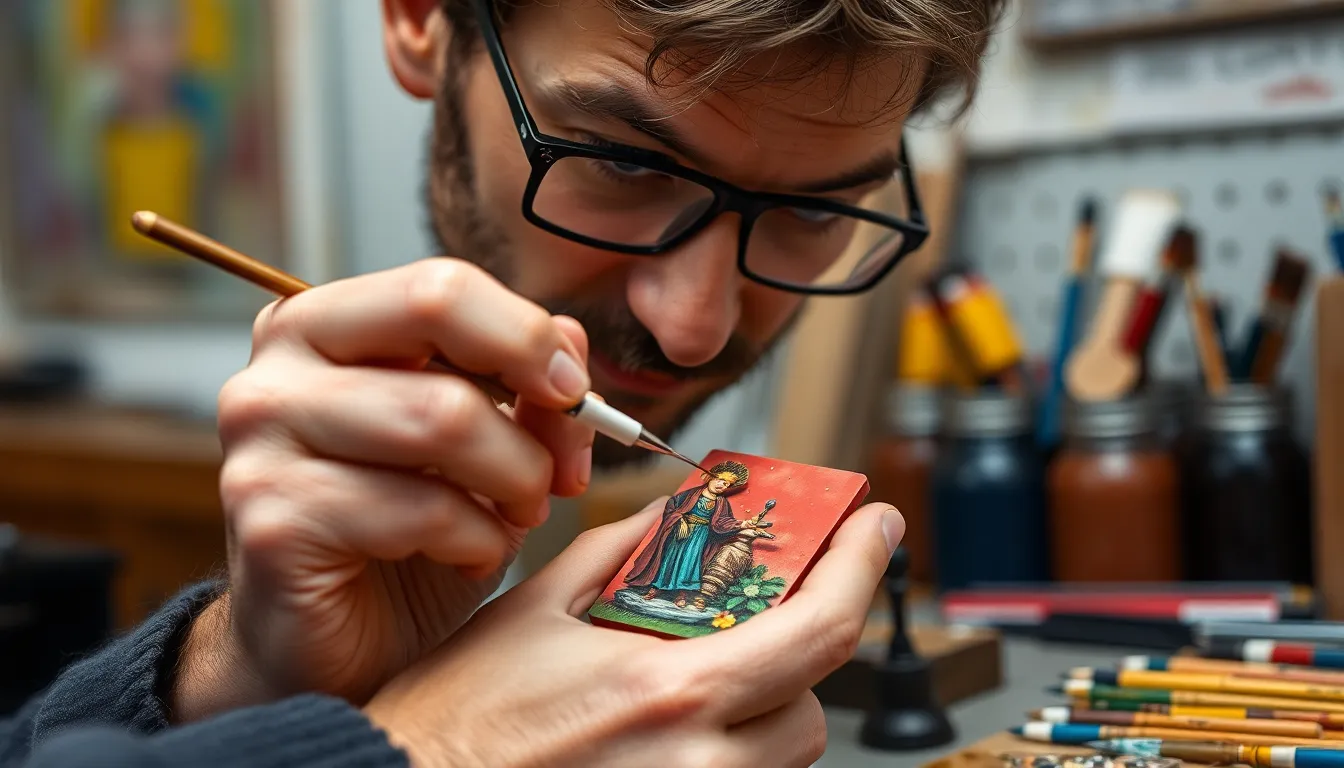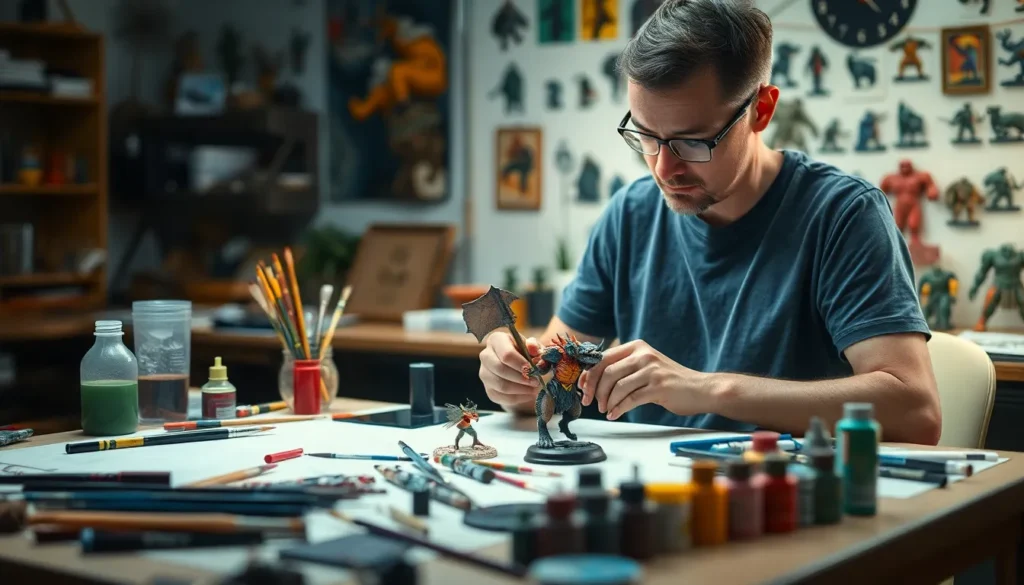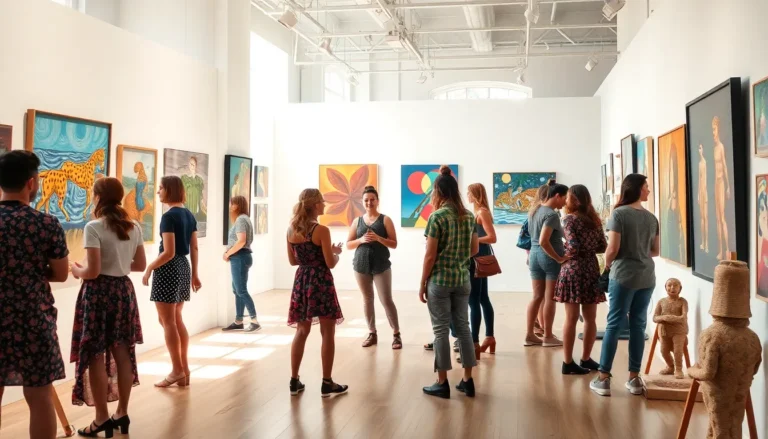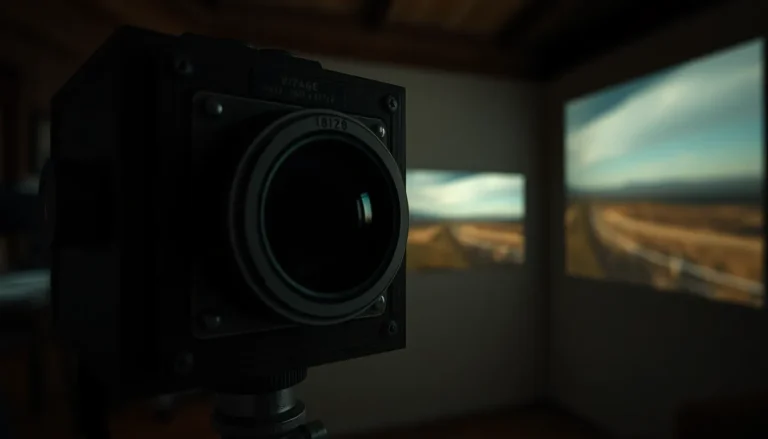Table of Contents
ToggleMiniature painting isn’t just for kids playing with toy soldiers; it’s a vibrant art form that transforms tiny figures into stunning masterpieces. Imagine capturing intricate details on a model so small it could fit in the palm of your hand. It’s like playing God in a dollhouse, and who wouldn’t want that power?
What Is Miniature Painting?
Miniature painting is an intricate art form focusing on the detailed embellishment of small figures. Artists engage with figures ranging from 28mm scale miniatures to larger, collectible versions. This activity transcends basic play with toy soldiers, inviting enthusiasts to explore creativity and craftsmanship.
The process involves several stages. First, individuals clean and assemble miniature pieces. Next, they apply primer to create a smooth surface. Afterward, they utilize various colors and techniques, such as layering, highlighting, and shading, to achieve depth and realism. Artists often employ tools like fine brushes and airbrushes to enhance precision.
Regarding the themes, miniature painting covers diverse genres. These encompass fantasy settings, historical battles, sci-fi universes, and tabletop games. In each genre, specific styles and detail levels can vary. For instance, Warhammer figures often exhibit elaborate designs, while Dungeons and Dragons miniatures emphasize character traits and features.
Communities around miniature painting thrive both online and offline. Groups gather for workshops, competitions, and exhibitions, creating a supportive environment for artists. Therefore, sharing techniques and critiques fosters growth and encourages innovation. Resources such as tutorials, videos, and forums provide invaluable knowledge for beginners and seasoned painters alike.
Miniature painting is an engaging hobby that combines artistic skill with a deep connection to storytelling. Whether as a form of self-expression or a dedication to gaming culture, this art form captivates many.
History of Miniature Painting

Miniature painting has a rich history that reflects cultural expressions across various civilizations. It showcases the evolution of artistic techniques and societal values over time.
Origins and Cultural Significance
Miniature painting dates back to ancient Egypt and Greece, where artisans crafted small figures for religious and ceremonial purposes. In medieval Europe, artists began using miniatures in illuminated manuscripts, highlighting significant events and figures. These tiny works served both decorative and educational roles. The art form conveyed messages and narratives while engaging patrons from nobility to common folk. As cultures interacted, the techniques and styles evolved, with influences from Asia and the Middle East enriching European miniature painting.
Evolution Through the Ages
The Renaissance marked a significant shift in miniature painting, emphasizing realism and detail. Artists like Hans Holbein and Alberto Durero exemplified this new approach, crafting intricate portraits. With the development of oil paints in the 15th century, painters achieved greater depth and vibrancy in their works. The 18th century saw the rise of miniatures as personal mementos, often incorporated into jewelry and accessories. During the 20th century, miniature painting gained traction in tabletop gaming and genres like fantasy and sci-fi, leading to a thriving community dedicated to this unique form of expression. The craft continues to evolve, embracing modern techniques and themes.
Techniques in Miniature Painting
Techniques in miniature painting encompass various methods and materials that enhance the artistry of small figures. Artists utilize specific tools and detailed processes to achieve desired effects.
Materials Used
Miniature painters rely on essential materials. Acrylic paints offer versatility, drying quickly for easy layering. A selection of brushes, ranging from fine-tipped for details to broader ones for base coats, ensures precision in application. Primers prepare surfaces for better paint adherence, enhancing durability. Additionally, flocking materials, like grass or snow, can create realistic bases that complement the painted figures. Sealants protect finished pieces, preserving intricate details against wear.
Step-by-Step Process
Every miniature painting project follows a sequence of steps. First, cleaning the miniature removes any mold lines or imperfections. Next, assembling pieces ensures correct alignment before priming, which provides a uniform surface. Artists then apply base colors, laying the groundwork for highlights and shadows. Dry brushing enhances textures by applying a lighter shade on raised areas. Finally, detailed highlights and washes add depth, bringing life to the miniature. Patience at each stage guarantees a professional-looking finish.
Popular Styles and Themes
Miniature painting showcases various styles and themes that capture the imagination of artists and collectors alike.
Historical Themes
Historical themes draw from real-world events and famous battles. Artists often focus on recreating figures from specific eras, like ancient Rome or medieval Europe. Attention to detail becomes crucial, with historically accurate uniforms and weaponry that reflect the period. Miniatures can depict iconic scenes, such as famous leaders or pivotal moments in history. Some artists utilize archival research to ensure authenticity, enhancing both the educational and artistic value of their work. This style invites enthusiasts to engage with history through a creative lens.
Fantasy and Sci-Fi Miniatures
Fantasy and sci-fi miniatures inspire creativity with whimsical and futuristic designs. In fantasy, artists bring mythical creatures to life, such as elves, dragons, and wizards. These miniature figures often feature vibrant colors and elaborate details that transport viewers to imaginary worlds. Sci-fi miniatures depict advanced technology and alien species, emphasizing sleek lines and innovative concepts. Artists in these genres push boundaries, experimenting with unconventional materials and techniques. This thematic diversity resonates with fans of tabletop games and immersive storytelling, keeping the excitement alive in miniature painting.
Tips for Beginners
Starting miniature painting requires understanding essential techniques and tools. By avoiding common pitfalls, beginners can enhance their skills and enjoy the process more fully.
Essential Tools and Supplies
Investing in quality tools significantly impacts the painting experience. Acrylic paints provide versatility, allowing for vibrant colors and easy mixing. Various brush sizes serve different purposes; finer brushes work well for details while broader ones cover larger areas. Primers ensure paint adheres properly, improving the final appearance. A palette for mixing colors aids in achieving desired shades. Additionally, a good magnifying glass helps in observing intricate details. Tweezers can assist with handling small pieces. Using a light box or natural light improves visibility during painting.
Common Mistakes to Avoid
Overlooking preparation often leads to disappointing results. Cleaning miniatures before painting prevents dust and residue from affecting the finish. Rushing the drying process can cause smudging and blending issues. Applying too thick a coat of paint reduces detail and increases drying time. Using the wrong paint can lead to chipping or poor adherence. Skipping highlights and washes means missing depth and dimensionality in the final piece. Failing to practice basic techniques can hinder skill development. Lastly, neglecting to enjoy the process can diminish creativity and fun in miniature painting.
Miniature painting stands as a unique blend of artistry and storytelling. It allows artists to express their creativity while engaging with rich historical and fantastical themes. The craft fosters a sense of community through shared experiences and learning among enthusiasts. As the hobby continues to evolve with new techniques and materials, it remains an exciting pursuit for both seasoned painters and newcomers alike. Embracing the challenges and joys of this art form can lead to a fulfilling journey of creativity and personal expression.







